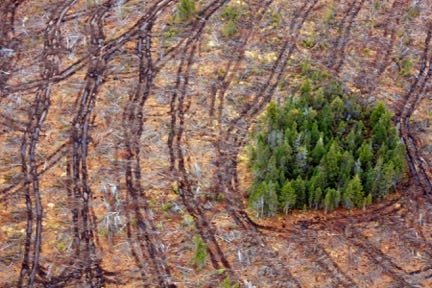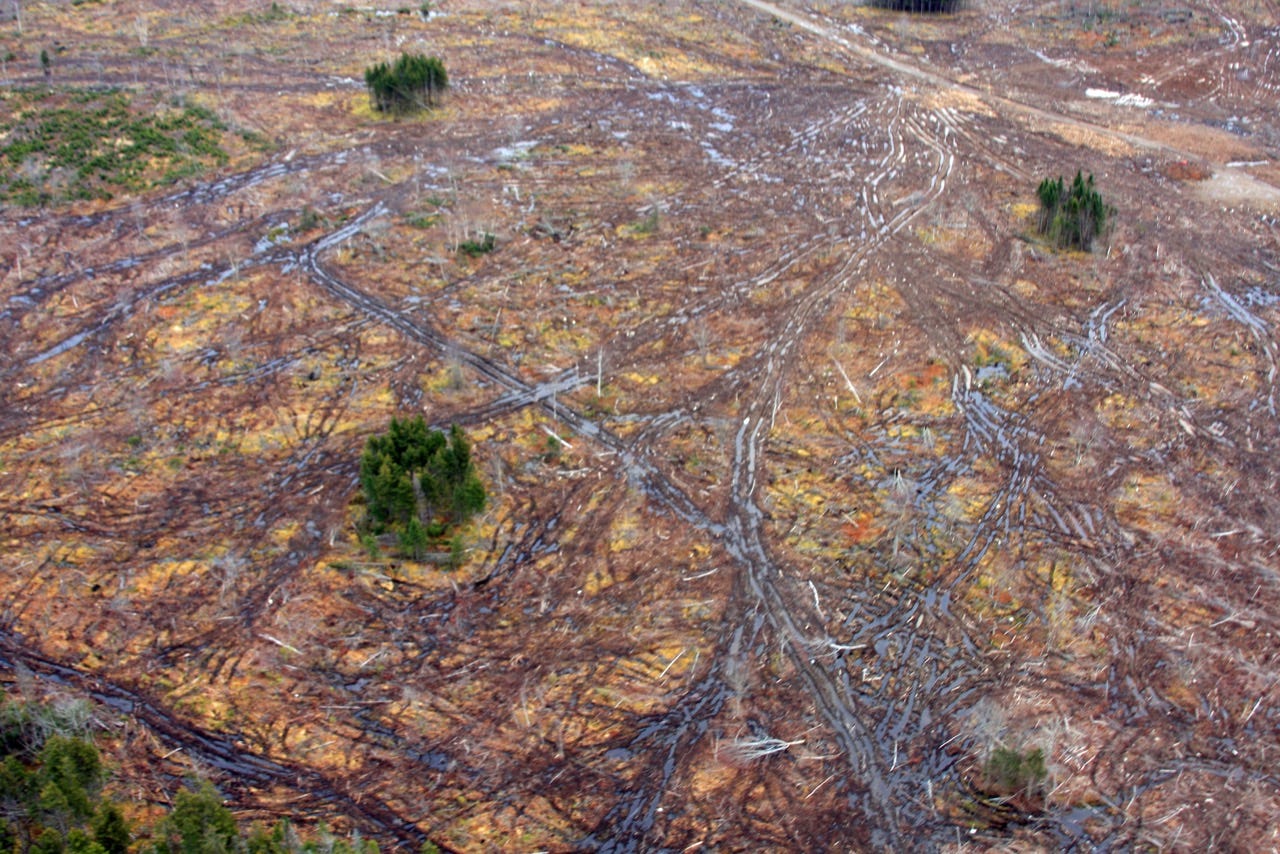The accounting that’s been used to justify the burning of trees for energy is fraudulent. It all started when the European Union promised that by 2020, 20 per cent of its electricity would be generated from the use of "carbon-neutral" or "non-carbon-emitting sources" and for some strange reason, biomass (trees) qualified. Suddenly biomass power plants started appearing all over — based on this false premise — which we’ll return to. But also, trees could be burned in coal-fired power plants without having to change any of the infrastructure. It was a quick and easy way to be “global leaders” and deliver on the climate change goals for 2020.
Blast furnace window at Nova Scotia Power Port Hawkesbury where they burn trees for electricity and call it a renewable energy. Photo courtesy Ray Plourde (Ecology Action Centre)
But a proper accounting was never done and here we are, burning trees to fight climate change? We’ve been duped, and more scientists are speaking out. For instance, in the build up to the UN biodiversity summit (Cop15), 650 scientists penned a letter stating that bioenergy is not “carbon neutral” and contributes to wildlife loss. The letter, addressed to President Xi, President Biden, Prime Minister Trudeau, Prime Minister Rishi Sunak, President von der Leyen, President Yoon Suk-yeol, and Prime Minister Fumio Kishida, states:
[Biomass] has wrongly been deemed “carbon neutral,” many countries are increasingly relying on forest biomass to meet net zero goals. This is harming our world’s forests when we need them most. Many of the wood pellets burned at power stations for bioenergy are coming from whole trees — not wastes and residues from logging, as the industry claims. For example, nearly half of all biomass burned at the UK’s Drax Power Station comes from whole trees.
Also disturbing is the fact that many of these trees are coming from old, biodiverse and/or climate-critical forests. For example, we know that wood pellets burned in the UK come from clearcuts of mature hardwood forests in the U.S. Southeast’s North American Coastal Plain Biodiversity Hotspot; protected forest ecosystems in the Baltics that are critical habitats for imperilled birds and mammals; and primary forests in Canada, including the boreal forest, one of the world’s last remaining intact forests and a stronghold for global bird populations. Rare species such as the prothonotary warbler, the boreal woodland caribou, and the black stork, are already declining due to the loss and degradation of these forests. Forests will become even more important for biodiversity in the future as vital havens for species impacted by climate change, especially if these species’ ranges shift due to a changing climate.
The letter is worth reading in its entirety.
It also points to another fraud: Many countries plan to scale up bioenergy use by adding carbon capture and storage or “BECCS” to meet net zero goals. “This is despite the serious questions over whether BECCS power would even remove carbon dioxide from the atmosphere by 2050 and high risks that all the supply chain emissions and efficiency losses would merely make matters worse.”
The scientists warn that if BECCS did become widely subsidized, countries would have to “significantly ramp up planting of bioenergy crops, which would diminish the land available for wildlife and natural ecosystems, and jeopardize global food security.” They cite this staggering estimate: the worldwide use of BECCS to achieve net zero would require up to 1.2 billion hectares of land — the equivalent of about 80% of all current global cropland. “Converting this much of the world’s land to bioenergy crops would leave little room for wildlife, preventing us from halting and reversing biodiversity loss (and risking global food and water security).”
Facts really don’t seem to matter anymore.
The reality is, there’s more carbon coming out of the stack when you burn wood than when you burn coal. But the assumption is that sometime in the future those emissions will be offset by new trees being planted, which are equivalent in mass to the trees that were cut, because trees and soil sequester and store carbon. But no one is making sure that new trees are planted. No one. The whole scheme is ludicrous and there should be an end to this fraud before crucial habitats are lost in the name of cutting greenhouse gas emissions.
“The best thing for the planet is to leave forests standing,” states the letter.
Northern Pulp harvest, Nova Scotia. Photo courtesy Jamie Simpson.
The Biomass Delusion
A few years ago I penned a review of the film “Burned: Are Trees the New Coal,” in which I interviewed Mary Booth, the Director and Ecosystem Ecologist for Partnership for Policy Integrity. She was also featured in the film. At the time, she explained to me that when burning biomass was embraced as a way to fight climate change, the industry wasn’t counting the greenhouse gas emissions coming out of the biomass stack. It was only counting the emissions from harvesting and transport. This, she said, is what got the whole conversation about carbon neutrality started.
Where did that accounting error come from?
Timothy Searchinger is a senior research scholar at Princeton University’s Center for Policy Research on Energy and the Environment. He is also lead author in the 2009 study in Science, that revealed the error. In the film, “Burned,” Searchinger explains, “We ended up developing an accounting rule for global national reporting that said for bioenergy purposes we’re going to count the carbon when you cut down the tree so we don’t have to count it again when it goes up the smoke stack. And that rule works if and only if you actually count the carbon when you cut down the tree.”
Searchinger says that the rule was designed to prevent you from counting carbon twice, but it became a rule that says you don’t count it at all. “Once that mistake had been made all kinds of people started thinking bio-energy could help solve our climate crisis. The problem is this mistake happened to also co-exist in a way to allow people to make a lot of money.”
So flawed accounting launched the biomass boom in the first place. Recognition of flawed accounting should stop it.
Northern Pulp harvest, Nova Scotia. Photo courtesy Jamie Simpson.
For further reading, here are some articles I’ve written on the subject of biomass, with a focus on Nova Scotia:
Feeding the Fire: Biomass and Nova Scotia’s Race for the Bottom
Life After Pulp: Energy Miracles, Jobs, and other Nova Scotia Government Delusions
Pulp Culture: Nova Scotia’s Faustian Bargain with the Pulp Industry may Leave the Sawmills in Ruins
Burned: Are Trees the New Coal (Film Review)
The “Biomass, Freedom of Information and the DNR Company Men” Series (5 parts)
Part 2: An Open Letter to the FOIPOP Review Officer
Part 3: What Happened When This Reporter got Called Down to the Office?







''Facts really don’t seem to matter anymore.'' You got that right! We live in 'Clown World' where lying is the norm. Thanks for calling them out on this fraud.